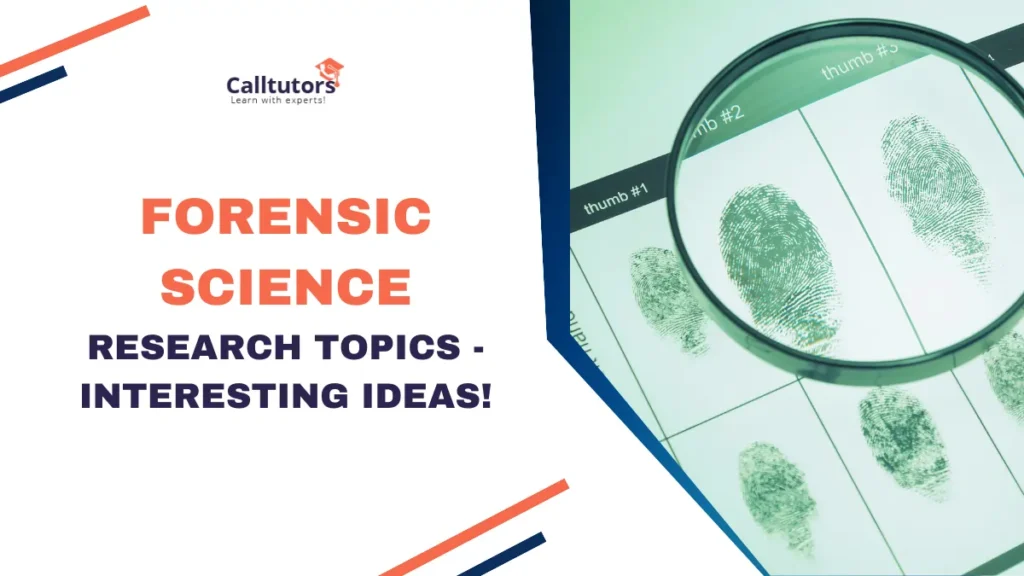Forensic science is critical in establishing the truth and achieving justice. Its combination of scientific theories with criminal investigation techniques in grasping the intricacies of criminal behavior.
Whether you are a curious learner looking for a fascinating research topic, an investigator who wants to delve deeper into this area, or even one who just loves forensics, exploring research ideas in this domain can be quite exhilarating.
From researching minuscule traces of evidence left at a crime scene to resolving cyber crimes within the digital sphere, much is on offer.
Well, then, prepare yourself to explore more than 111 captivating forensic science topics that will fascinate your mind, make you reflect deeply, or even generate groundbreaking results that could revolutionize how cases are investigated by law enforcement and adjudicated by courts worldwide.
This exhaustive list covers multiple interests and academic levels; hence, you are bound to find a field that matches your interests and goals.
Take A Look At The Concept Of Forensic Science
Table of Contents
Forensic science involves using scientific techniques to investigate crimes and gather evidence. It aids in solving legal cases by providing facts and information.
The main aspects include:
- Crime scene examination: When a crime occurs, specialists visit the location to collect and analyze physical evidence like fingerprints, blood stains, hair, fibers, and other traces left behind.
- Laboratory testing: The collected evidence undergoes careful laboratory examination and testing using advanced equipment and methods. This includes techniques such as DNA analysis, studying firearms and bullets, analyzing drugs and poisons, and examining handwriting, ink, and paper.
- Event reconstruction: Specialists use their findings and analysis to reconstruct the events surrounding the crime. They try to determine how the crime was committed, who was involved, and what happened during the incident.
- Court testimony: Specialists may be called to present their findings and explain the scientific evidence to judges and juries in court trials. Their testimony can be crucial in helping to solve the case and determine guilt or innocence.
The primary objective of forensic science is to apply scientific knowledge and methods to legal investigations, providing objective and reliable evidence that can help reveal the truth and bring justice to criminal cases.
Recommended Reading: “189+ Most Amazing Ecology Research Topics For College Students!“.
Significance of Research in Forensic Science
Research in forensic science isn’t just some academic exercise—it’s vital for pushing this field forward and keeping our justice system running. We can’t overstate how crucial ongoing research is for developing more accurate, reliable ways of analyzing evidence and investigating crime scenes.
Think about it – forensics can’t just stay stagnant using the same old techniques year after year. Crime is an ever-evolving beast, and we need to evolve, too, through continuous research into cutting-edge methods. That’s how we get game-changers like advanced DNA profiling tech or novel digital forensics tools for cracking cyber crimes. Research paves the way for those next-level innovations that keep us one step ahead of the criminal element.
But it’s not just about coming up with brand-new tricks. Plenty of research goes into fine-tuning and optimizing the techniques we already use. Why settle for good when you can make it great, right? By endlessly tweaking and improving our current methods through rigorous study, we boost their accuracy and make them applicable to more scenarios out in the field.
Speaking of out in the field, you know evidence has to withstand intense scrutiny to be court-admissible. Research does the heavy lifting of validating our forensic techniques, giving them solid scientific credibility to stand up in legal proceedings. No shaky pseudoscience is allowed when the stakes are liberty itself.
The forensic frontier is constantly shifting with new technologies and criminal trends emerging. Research allows us to adapt proactively and develop countermeasures instead of playing catch-up. We’re not reacting to new threats – we’re getting ahead through dedicated forensic study.
Let’s not forget that forensics involves many different scientific disciplines, such as biology, chemistry, and physics. Research encourages cross-collaboration between these fields, allowing the free exchange of ideas and expertise. This is where you get legitimately outside-the-box solutions no one field could produce alone.
Skimping on forensic research cripples the entire justice system. But nurturing that spirit of scientific inquiry? That’s how we keep forensics sharp, reliable, and primed to guard the integrity of the law. Justice depends on ensuring our methods are rigorously researched and validated – no ifs, ands, or buts.
Top 111+ Forensic Science Research Topics
The top 111+ forensic science research topics list is organized into different categories. Let’s look.
DNA Analysis
- Studying new ways to look at DNA for solving crimes.
- Problems with looking at special parts of DNA called mitochondria.
- Using fancy new machines to study DNA for solving crimes.
- Figuring out family connections using certain parts of DNA.
- Making sure we do DNA stuff in a fair and good way.
Digital Forensics
- Carefully saving computer stuff when solving crimes.
- Figuring out computer crimes using special tools.
- Studying phones and tablets to solve crimes.
- Tracking money on the internet for solving crimes.
- Studying smart gadgets like watches and thermostats for solving crimes.
Trace Evidence Analysis
- Using tiny things to solve crimes.
- Studying tiny bits from guns to solve crimes.
- Looking at hair to help solve crimes.
- Figuring out where glass or paint comes from in solving crimes.
- Studying dirt and pollen to solve crimes.
Forensic Anthropology
- Figuring out how old, male/female, or where someone’s from by looking at their bones.
- Studying what happens to bones after someone dies.
- Making faces from bones to help solve crimes.
- Looking at broken bones to solve crimes.
- Identifying people after disasters using bones.
Forensic Toxicology
- Studying new drugs and how to find them in bodies.
- Figuring out what happens to drugs after someone dies.
- Using special tools to find new drugs in bodies.
- Studying genes and drugs in bodies.
- Studying new drugs like kratom and fake weed in bodies.
Bloodstain Pattern Analysis
- Using math to understand blood spots.
- Figuring out crime scenes using blood spots.
- How blood spots change depending on speed, angle, and surface.
- Understanding blood spots from gunshots.
- Problems with understanding blood spots.
Forensic Entomology
- Figuring out how long someone’s been dead by looking at bugs.
- Studying bugs on dead people in different places.
- Using bugs to find drugs or poisons in dead people.
- Problems with using bugs to solve crimes.
- Bugs in crime scenes.
Forensic Odontology
- Looking at teeth to solve crimes.
- Figuring out someone’s age using teeth.
- Identifying people using dental records.
- Problems with identifying people using bite marks.
- Problems with bite marks.
Forensic Psychology
- Understanding criminals using their behavior.
- Figuring out if someone’s telling the truth by how they act.
- Using lie detectors to solve crimes.
- Understanding criminal behavior.
- Figuring out if someone can understand a trial.
Forensic Pathology
- Studying dead bodies to solve crimes.
- Looking at dead babies to figure out why they died.
- Understanding deaths from not being able to breathe.
- Changes in dead bodies over time.
- Using machines to look inside dead bodies.
Wildlife Forensics
- Studying animal DNA to solve crimes.
- Figuring out illegal animal trading.
- Using DNA to find out what animal a product comes from.
- Studying animal parts like elephant tusks and rhino horns in crimes.
- Using science to help animals stay safe.
Forensic Linguistics
- Figuring out who wrote something using words.
- Studying how people talk to find out who they are.
- Understanding mean messages in crimes.
- Studying how people write to find out who they are.
- Using computers to help with language stuff.
Forensic Archaeology
- Digging up old bones to solve crimes.
- Using fancy tools to find old bones.
- Solving old crimes with bones.
- Studying dirt to solve crimes from a long time ago.
- Using special machines to look for old things.
Forensic Chemistry
- Using chemicals to solve crimes.
- Studying bombs and stuff after they go off.
- Finding out what drugs are made of to solve crimes.
- Studying drugs using fancy tools.
- Using chemistry to solve fires and things that burn.
Forensic Engineering
- Figuring out why things break in crimes.
- Understanding car crashes by looking at them closely.
- Figuring out why buildings and bridges fall.
- Figuring out if things are broken on purpose.
- Using computers to help figure out why things break.
Forensic Nursing
- Nurses help solve crimes like assault.
- Nurses are helping kids whose families are hurt.
- Nurses write about what they see in crimes.
- Special nurses who help victims of assault.
- Nurses help old people whose families are hurt.
Forensic Genetics
- Figuring out who someone is by looking at their genes.
- Finding families using genes.
- Using genes to change things in a good way.
- Problems with genes when they’re old and broken.
- Using genes to solve crimes in a new way.
Forensic Data Analysis
- Using numbers to solve crimes.
- Studying money to solve crimes that are about money.
- Using computers to solve internet crimes.
- Using computers to help with numbers in crimes.
- Using pictures to help show what happened in crimes.
Forensic Botany
- Using plants to solve crimes.
- Studying plant dust to solve crimes.
- Using genes to look at plants in crimes.
- Figuring out where plants come from to solve crimes.
- Using plant stuff to solve old crimes.
Forensic Biomechanics
- Studying how people get hurt in crimes.
- Understanding brain injuries from being hit.
- Studying broken bones from abuse.
- Using computers to understand how guns hurt people.
- Studying how guns hurt people.
Forensic Psychiatry
- Understanding crazy stuff in crimes.
- Figuring out who’s going to do something bad next.
- Understanding how doctors help in crimes.
- Using medicine to help people in crimes.
- Making people feel better after crimes.
Forensic Photography
- Taking pictures to show what happened in crimes.
- Taking 3D pictures to show what happened in crimes.
- Using pictures to show how things happened in crimes.
- Finding out if pictures have been changed in crimes.
- Taking pictures of things that are hard to see.
Forensic Nursing
- Nurses help solve crimes like assault.
- Nurses were helping kids whose families were hurt.
- Nurses write about what they see in crimes.
We have covered the different realms of forensic science and provided the science research topics for them so that you can grasp every concept related to forensic science.
Challenges in Forensic Science Research
Here is the list of challenges and obstacles that students generally face while preparing a well-researched forensic science research topic
- Limited resources and funding for research
- Maintaining objectivity and avoiding bias
- Keeping up with rapidly evolving technologies
- Standardizing procedures across different labs/agencies
- Dealing with complex crime scenes and evidence
- Ensuring proper handling and storage of evidence
- Overcoming cognitive biases in analysis and interpretation
- Lack of adequate training programs and educational opportunities
- Establishing solid statistical models and error rates
- Addressing ethical concerns and privacy issues
- Bridging the gap between research and practical application
- Improving quality assurance and proficiency testing
- Difficulties in conducting controlled experiments or recreating crime scenarios
- Challenges with interdisciplinary collaboration across fields
Closing Up
The study of forensic science is vast and constantly changing. It offers researchers many opportunities to explore new areas and solve difficult problems.
The research subjects in this list cover a wide range of specialties, from the latest fields of digital evidence and cyber crime investigation to the complex topics of analyzing poisons, studying guns and bullets, and recreating crime scenes.
As technology improves and new dangers appear, forensic scientists must develop innovative methods, refine their techniques, and stay ahead in their fields. By exploring these fascinating research areas, scholars and professionals can contribute to finding the truth, maintaining justice, and improving society.
Whether driven by an eagerness to learn or a desire to serve the public, the vast potential of forensic science research invites those passionate about uncovering the intricate details at the heart of criminal cases.
FAQs
What are some unique research topics in forensic science?
Some unique research topics in forensic science include the analysis of digital evidence in cybercrimes, using plant evidence in forensic botany, and applying geospatial analysis in forensic geology.
How does forensic science research contribute to solving cold cases?
Forensic science research contributes to solving cold cases by reanalyzing existing evidence using advanced techniques, developing new methods for analyzing forensic evidence and applying interdisciplinary approaches to uncover new leads and information.
What role does forensic anthropology play in criminal investigations?
Forensic anthropology plays a crucial role in criminal investigations by analyzing skeletal remains to determine the identity, age, sex, and ancestry of individuals, as well as identifying trauma or injuries that may provide clues about the cause of death.



